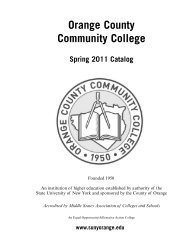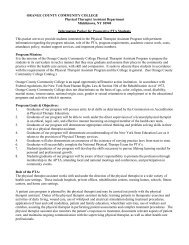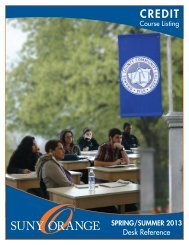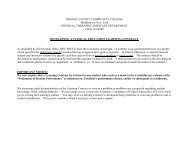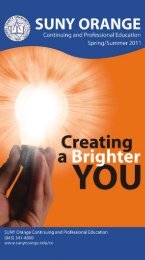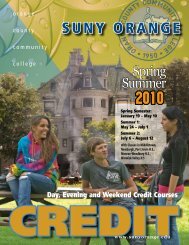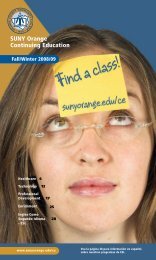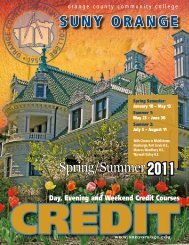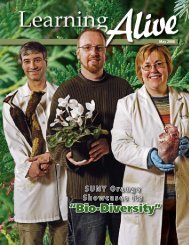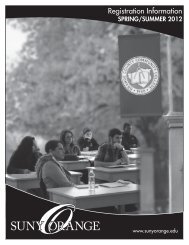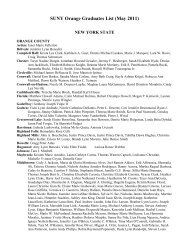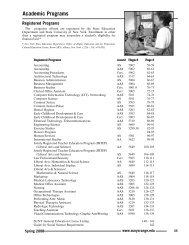Create successful ePaper yourself
Turn your PDF publications into a flip-book with our unique Google optimized e-Paper software.
Architectural Technology<br />
Degree Awarded: Associate in Applied Science<br />
Recommended Course Sequence<br />
First Semester<br />
Credits<br />
ENG 101 Freshman English 1 3<br />
MAT 107 Technical Math 1 3<br />
CAD 101 Introduction to CAD 3<br />
ARC 101 Architectural Graphics 3<br />
ARC 105 Bldg Materials & Methods 1 2<br />
ARC 111 Architectural Design 1 3<br />
Second Semester<br />
ENG 102 Freshman English 2 3<br />
CAD 102 Computer Aided Drafting 2 2<br />
ARC 102 Advanced Arch. Graphics 3<br />
ARC 106 Bldg Materials & Methods 2 4<br />
ARC 112 Architectural Design 2 3<br />
ARC 215 Architecture to the 18th Century 3<br />
Third Semester<br />
_______ Social Science Elective 3<br />
PHY 111 Applied Physics 1 3<br />
ARC 211 Architectural Design 3 3<br />
ARC 205 Working Drawings 1 3<br />
ARC 201 Digital Portfolio 1<br />
ARC 216 Architecture from the 19th C 3<br />
PES 100 Concepts of Physical Wellness 1<br />
Fourth Semester<br />
_______ Social ScienceElective 3<br />
ARC 220 Mechanical and Electrical Equip. 3<br />
ARC 206 Working Drawings 2 4<br />
ARC 212 Architectural Design 4 4<br />
ARC 221 Strength of Materials 3<br />
PES ____ Physical Education 1<br />
Total Credits: 70<br />
Program Description<br />
The Associate in Applied Science degree program in<br />
Architectural Technology prepares graduates to enter the<br />
workforce as architectural team members. While other<br />
opportunities exist, the largest job opportunities are positions<br />
as interns / CAD operators for architectural firms. Graduates’<br />
skills will prepare them to produce working drawings in a<br />
variety of settings, such as engineering firms or<br />
manufacturers. If graduates have field experience in a<br />
building trade, all program outcomes are directly transferable<br />
to entry-level positions in construction management and<br />
supervision. A broad cross-section of course content is<br />
covered in the program; this familiarizes students with many<br />
aspects of the architectural profession, the work of building<br />
professionals and the construction process.<br />
When working under the supervision of a licensed<br />
professional (i.e. Registered Architect, Professional Engineer,<br />
etc.), a graduate’s primary responsibilities would include<br />
measuring and documenting existing conditions of buildings<br />
and sites, preparing construction documents, interpreting<br />
construction documents, preparing design presentations for<br />
clients or other audiences, and coordinating architectural<br />
drawings with consultants’ drawings.<br />
Fluency with computer-aided drawing (AutoCAD) and<br />
computer literacy, as it applies to generating architectural<br />
drawings, are fundamental skills graduates will possess.<br />
Meanwhile, freehand sketching is stressed wherever possible<br />
as a valuable communication method. Beyond preparing<br />
construction drawings, students will build models, prepare<br />
reports and orally present their work to groups.<br />
Most courses in the program are a combination of lecture<br />
and lab. In the lecture component, foundational material is<br />
presented, often accompanied by samples, examples or other<br />
visual cues. In the lab component, students will either work<br />
on short-term exercises designed to hone very specific<br />
knowledge bases or skills or they will work on long-term<br />
projects designed to simulate the types of projects that they<br />
will eventually encounter in the workforce. Students should<br />
be prepared to spend a significant amount of time on projects<br />
outside the classroom.<br />
Many students who enter this degree program plan to<br />
transfer to an upper division institution. Because these<br />
opportunities exist, second year students who intend to<br />
transfer should select their courses in careful consultation<br />
with their academic advisor. Portfolio production will be<br />
required.<br />
For those students wishing to become Registered<br />
Architects, New York State Department of Education<br />
guidelines must be followed. To become a Registered<br />
Architect, one must earn an NAAB-accredited Bachelor of<br />
Architecture or Master of Architecture degree, fulfill<br />
NCARB internship requirements (a proscribed three year<br />
apprenticeship), and pass a challenging and comprehensive<br />
licensing examination.<br />
70 www.sunyorange.edu Spring 2012




